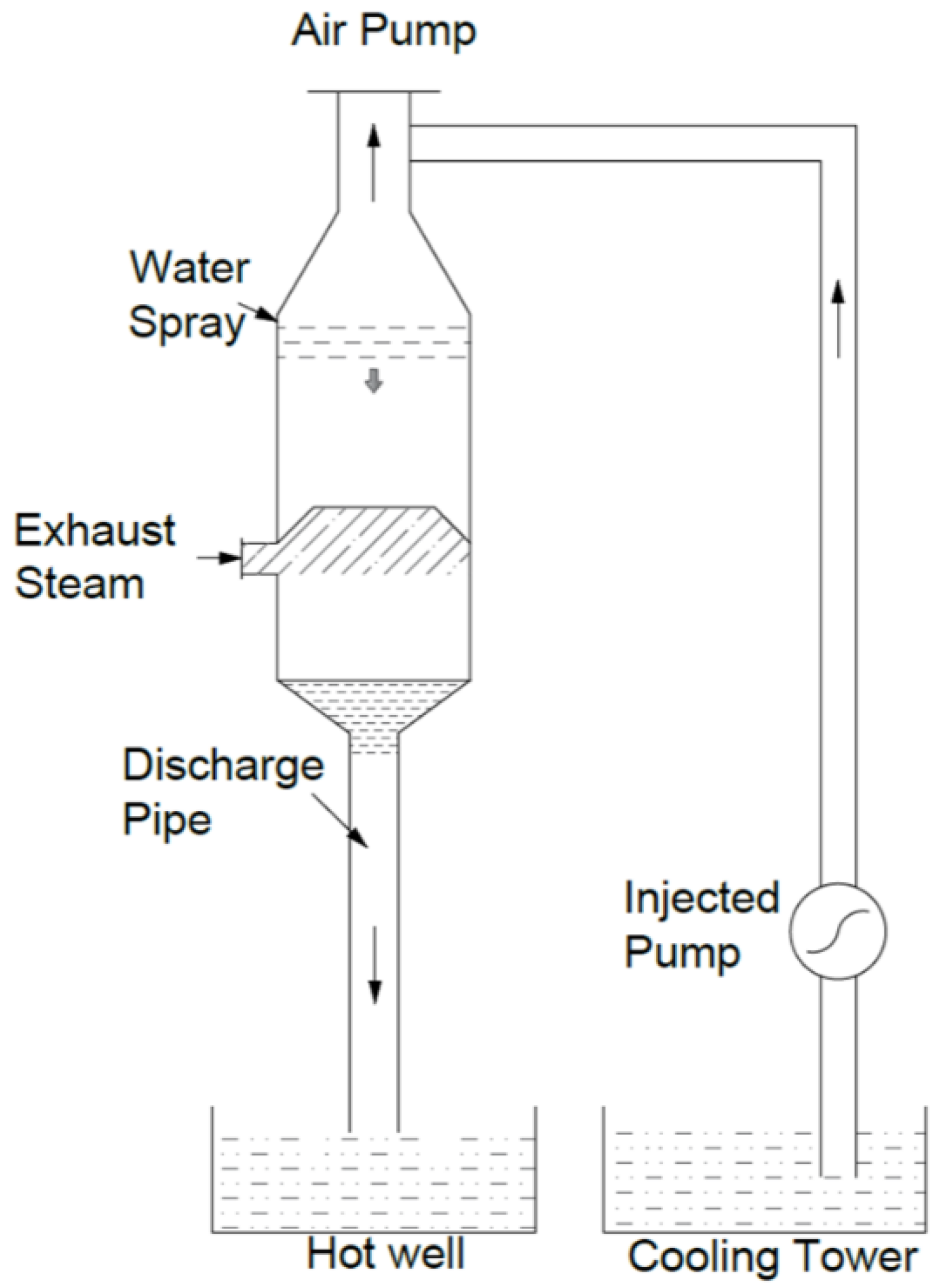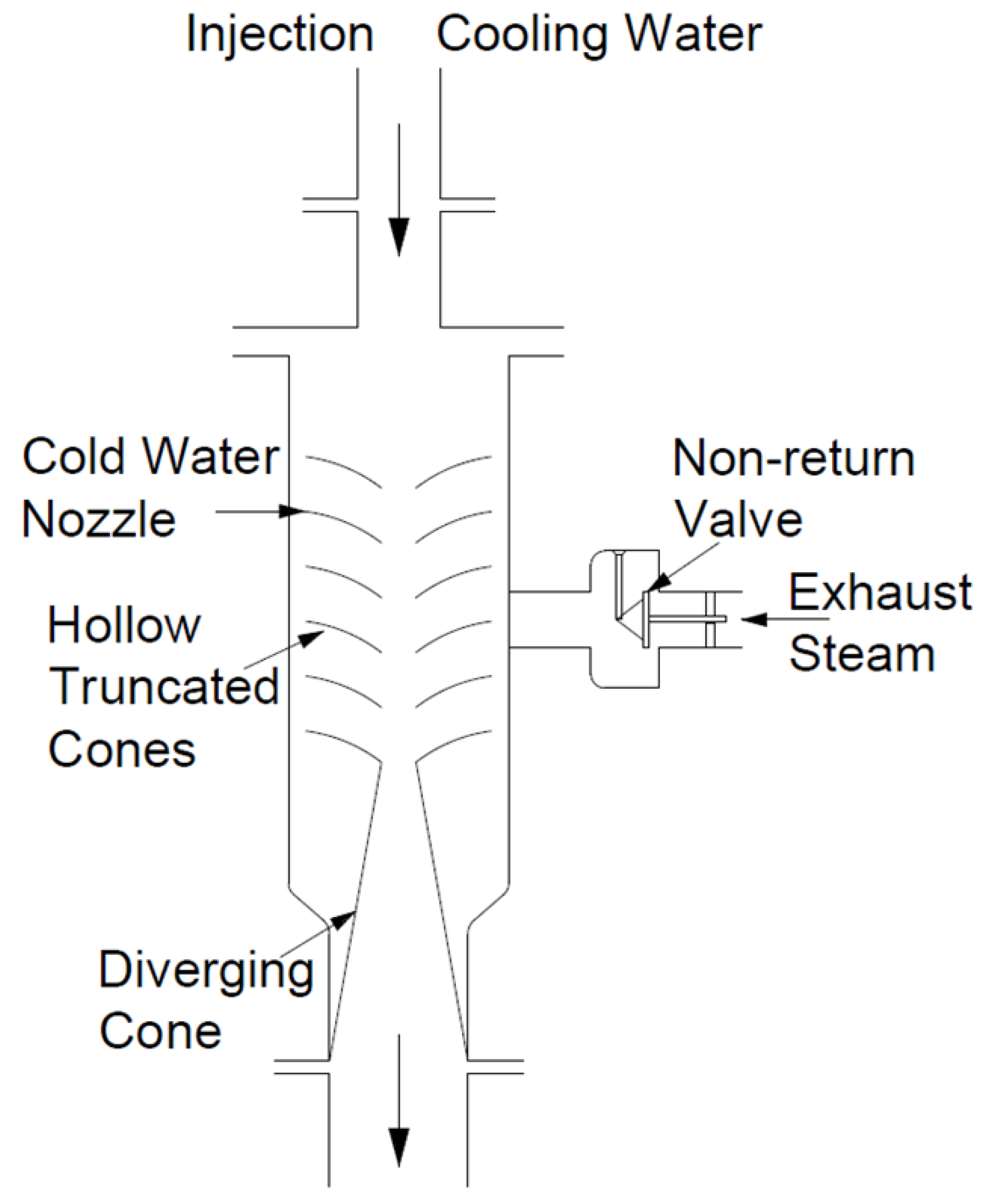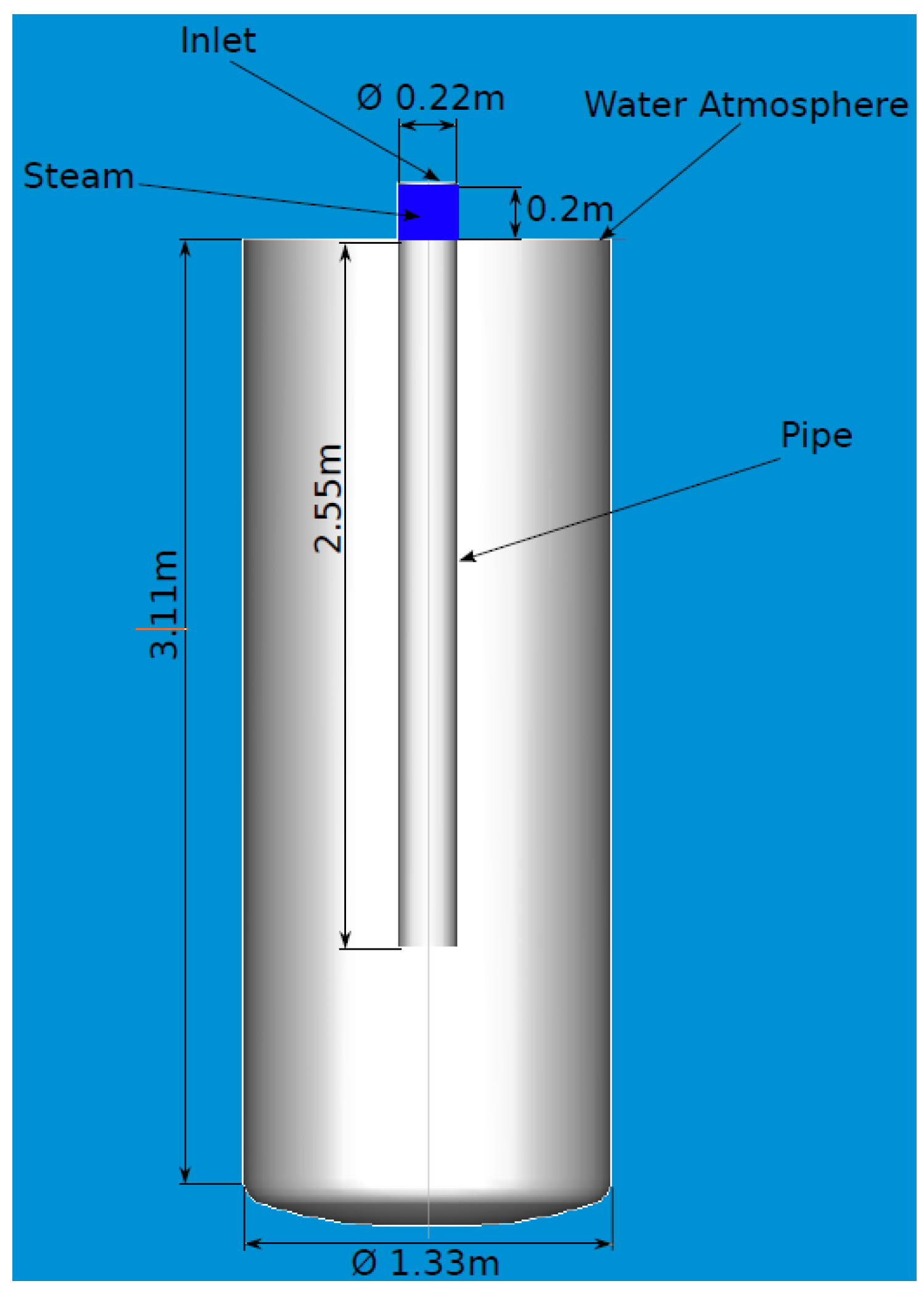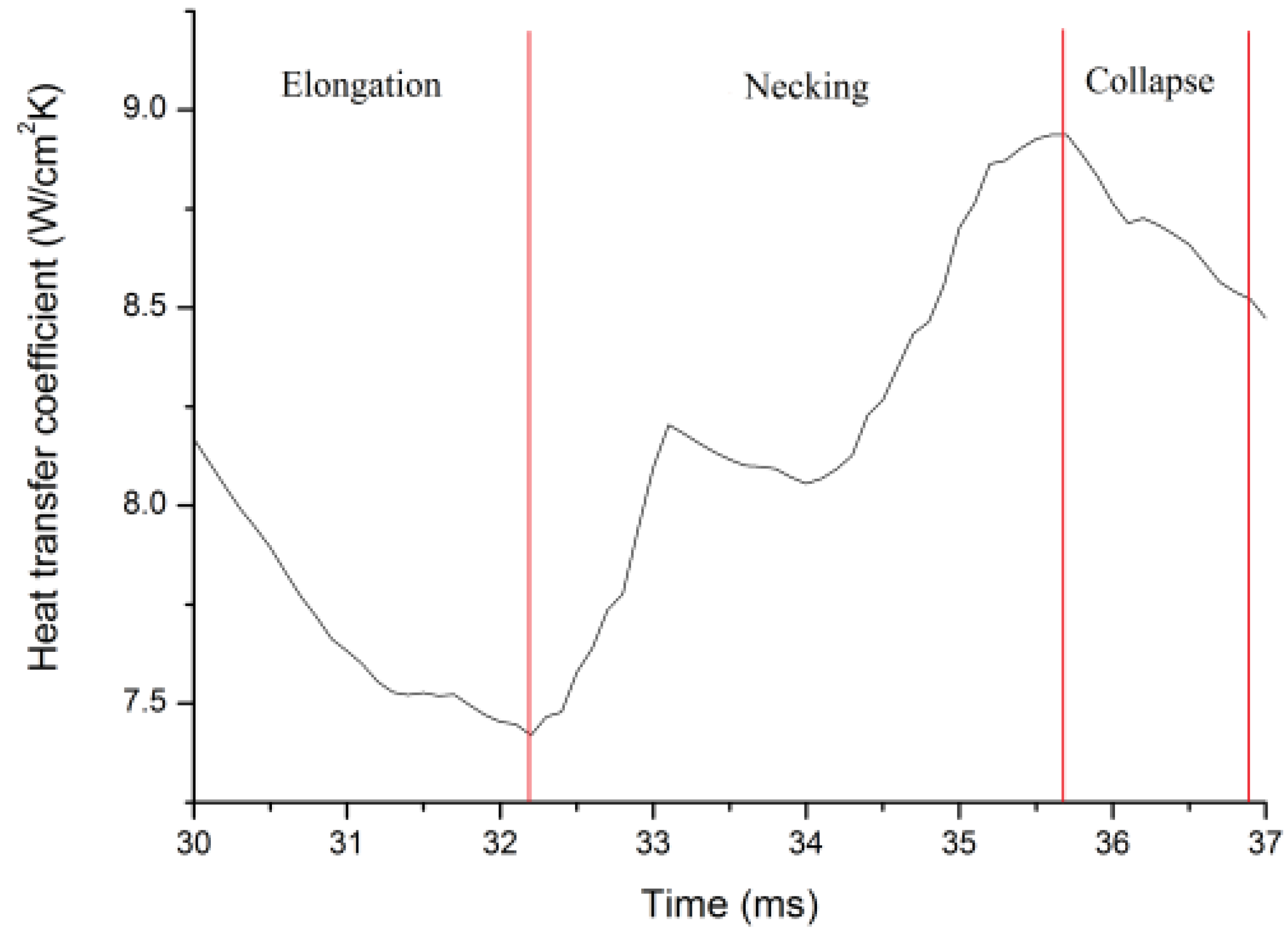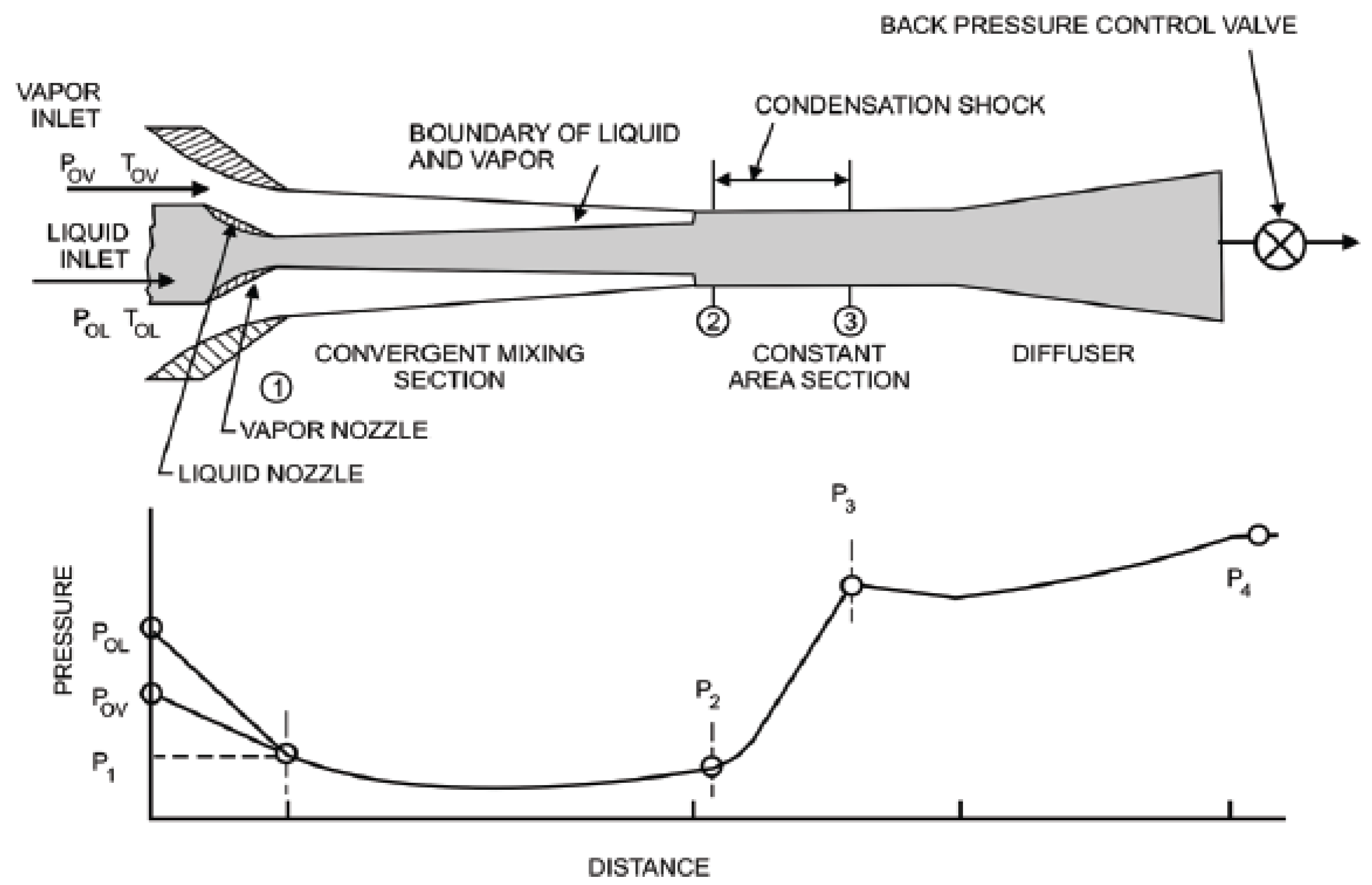3.2. Parallel Flow Condensers
The Thermochemical Power Group (TPG) at the Polytechnic School of the University of Genoa developed and implemented the contact condenser test rig [
36,
37,
38,
39] (
Table 2). It was intended for studies on the humid air turbine cycle where water introduction in a gas turbine circuit is provided by a pressurised saturator (i.e., humidification tower or saturation tower).
Changing input variables at the levels given in
Table 3, the authors performed 162 tests in total. Data analysis was provided using two types of correlations for the non-dimensional outlet air temperature, i.e., based on polynomial correlation:
and applying non-dimensional parameters, as non-dimensional temperature (T*), mass flow (
M*) and the Reynolds number of inlet air (
Re*):
and:
Equation (5) was derived based on enthalpy balance and assuming an adiabatic saturation process. The standard deviation of 2.5 K and 2.8 K were obtained in the first and second case, respectively. Hence, presented relationships can be used when designing structured packing saturators.
In the work [
39] the same rig was used to validate the numerical code TRANSAT developed to simulate the transient performance of direct contact heat exchangers. The error for water temperature was less than 1%.
Zare et al. [
40] analysed a steam-water system with a vertical square cross-section pipe supplying equipment (
Table 4). The high-speed camera (set at 100 fps) photographed the studied phenomenon.
Based on experimental data and employing a genetic algorithm, authors developed an empirical correlation for the average heat transfer coefficient steam-water der direct contact condensation:
with:
λw—thermal conductivity of water, W/(m·K),
D—hydraulic diameter of the test section, m,
B—condensation driving potential, -
Gm—critical steam mass flux, Gm = 275 kg/m2 s at an atmospheric condition
G0—Steam mass flux, kg/m2 s.
Under experimental conditions (
Table 5) the calculated average heat transfer coefficient was within the range of 0.716–3.131 MW/(m
2 K).
Datta et al. [
41] investigated direct contact condensation during subcooled water injection into a horizontal pipe supplied with steam. The test section was made of stainless steel. A steam tank was used as a steam accumulator (
Table 6). Three pressure and five temperature sensors were mounted along the test section to provide their temporal variations.
During experiments, steam and water pressure varied from 2 to 3 bar and from 3 to 6 bar, respectively. Supplying water temperature was maintained about 30 °C. Steam temperature was from 120.2 °C to 133.5 °C. Authors observed higher pressure peaks (up to 6.08 bar) in the test section when the rising pressure difference between its inlet and water section was up to 3 bar.
Karapantsios et al. [
42,
43] considered a steam—air system using a vertical and transparent column 2660 mm high with 50 mm of internal diameter. They divided the column into the inlet (300 mm), intermediate (900 mm), and measurement (1400 mm) sections. Inlet steam pressure was maintained constant at 1.5 bar. The water flow rate was changed within the range of 26 to 416 g/s.
They defined a condensation heat transfer coefficient:
with:
L—latent heat, J/kg,
ΔWc—condensation rate, kg/s·m.
ΔT—temperature difference, K,
Δx—distance between measuring points, m.
Then the cumulative heat transfer coefficient was analyzed, assuming as ΔT the logarithmic mean temperature difference. During experiments, it varied between 500 and 2000 W/m2 K for the entire condensing region (at heights between 0 and 690 mm from the steam entry).
The steam condensation subatmospheric conditions in the concurrent flow packing tower were investigated by Chen et al. [
44]. As the direct contact condenser, they used a stainless steel 1000 mm high column with 300 mm of internal diameter. A steam generator with 0–144 kW of heating power and a 1.5 kW vacuum pump (6 × 10
−2 Pa and flow rate of 15 L/s) were used.
During an impact of steam temperature T
cond, steam flow G
in, inlet water temperature T
in, and water flow L
w on the condensation process was studied. These parameters were set at values given in
Table 7.
The authors analyzed several parameters, such as condensation rate (R), degree of subcooling (ΔT), number of liquid-phase heat transfer units (NTUL), and the total volume heat transfer coefficient K
V. The relationship gives the latter one:
with:
cpL—specific heat at constant pressure, J/(kgK),
GL—mass flow rate of cooling water, kg/s,
Tin—inlet temperature of cooling water, K,
Tout—outlet temperature of cooling water, K,
ΔTm—logarithmic average temperature difference during condensation, K,
V—volume from the liquid distributor to the stable liquid level of the tower bottom, m3.
During experiments, K
V varied from 80 to 250 kW/(m
3 K). After fitting to experimental data, authors provided the correlation in the form:
with F
LG given by the equation:
Ma et al. [
35] analyzed steam condensation in the presence of non-condensable gas (steam-nitrogen and steam argon) in relation to pure steam and estimated the heat transfer coefficient in relation to various conditions (pressure, gas content). The test section was the 1669 mm high tube with 5 mm and 8 mm inner and outer diameters, respectively. It was placed in a cylindrical container, 3660 mm high and with an internal diameter of 40 mm.
The test section was the tube-in-tube type, made of an inner tube with an outer diameter of 34 mm and an outer condensing tube with an inner diameter of 60 mm, and located in the axial centre of a stainless steel vessel with an inner diameter of 0.4 m and a height of 3.66 m. At its bottom were electrical heaters with power controlled from 0 to 60 kW, used to heat water. The condensing section had a height of 1.669 m. The thickness of the inner and outer tubes was 5 mm and 8 mm, respectively. A 60 kW electric heater was used to heat up water. The mass fraction of N
2/Ar was between 5% and 90%. Other experimental conditions are given in
Table 8.
During pure steam condensation, when increasing the bulk pressure from 0.21 MPa to 3.12 MPa, the average condensation heat transfer coefficient, hc, increased from 1.74 kW/(m2 K) to 8.95 kW/(m2 K). The introduction of non-condensable gases significantly influenced obtained results. In the presence of N2 with a mass fraction of 11.5% hc increased from 0.99 kW/(m2 K) to 4.37 kW/(m2 K) under the system pressure rise from 0.21 MPa to 3.11 MPa. They also noticed that under constant pressure, the condensation heat transfer coefficient decreases along with the increase of non-condensable gas share. They gave a case for 4.12 MPa bulk pressure and the mass fraction of N2 increased from 8.41% to 81.5% when hc decreased from 6.12 kW/(m2 K) to 0.54 kW/(m2 K).
3.3. Counter Flow Condensers
Genic [
45] analyzed a water and steam system (
Table 9) comprising a 300 mm diameter column for water deaerators with downcommerless trays.
The author derived experimental correlation for the number of transfer units for the liquid phase (NTU
L), with a correlation ratio of 0.925 and standard deviation of 15.9%, in the following form:
with:
GL—mass flow rate of liquid, kg/s,
GS,in—inlet mass flow rate of steam (vapour), kg/s,
ρL—liquid density, kg/m3,
ρS—steam (vapour) density, kg/m3.
In the next study [
46] based on the same test rig, authors investigated heat transfer during direct-contact condensation on baffle trays. They presented the experimental correlation for Nusselt number based on dimensionless numbers:
With a correlation ratio of 0.983 and a standard deviation of 13.3% sufficient for engineering design purposes.
In the study of Chen et al. [
47], the authors investigated sonic steam jet condensation in sonic flow of water. Visualization of steam plumes was performed using a high-speed camera. Then digital image processing with Matlab software was applied. The test rig was set to provide the maximum steam flow rate of 126 kg/s (
Table 10). The test conditions are given in
Table 11.
The authors distinguished five considered plume shapes: hemispherical, conical, contraction-expansion-contraction, ellipsoidal, and divergent, and presented a 3-D map of these shapes.
Introducing, as in previous studies, several dimensionless parameters authors derived experimental correlation for average heat transfer coefficient:
Under presented experimental conditions, h
av varied Nusselt number:
with:
de—diameter of steam nozzle exit, mm,
Gm—critical steam mass flux,
Ge—steam mass flux, kg/m2 s.
The presented model produced results with an accuracy of 20% when comparing the experimental data. The measured heat transfer coefficient was within the range of 1.6–5.5 MW/m2 K.
Fei [
48] and Xu [
49] investigated bubbles’ uniformity and mixing time in a direct contact heat exchanger. They used a two-component system with heat transfer fluid (HTF) and R-245fa under the test conditions presented in
Table 12.
The authors concluded that there was a linear relationship between the flow patterns of a bubble swarm and heat transfer.
Xu et al. [
33] investigated direct-contact condensation of the steam jet in water flow in pipes. The authors investigated the average heat transfer coefficient and Nusselt number. They also observed the plume’s shape and length using a high-speed camera. The test conditions are given in
Table 13.
Finally, they presented experimental correlations to obtain average heat transfer coefficients. For Reynolds numbers from 2456 to 29,473:
For 29,473 ≤ Re < 117,893:
B—condensation driving potential
Cp—water-specific heat, J/kgK
Ge—steam mass flux at nozzle exit, kg/m2 s
Gm—critical steam mass flux, kg/m2 s
Its value during experiments was within the range of 0.34–11.36 MW/m2 K.
Mahood et al. [
34] presented an experimental test facility for the investigation of a three-phase direct contact condenser using three phases (pentane, liquid-, vapor-water). A test section was built in the form of a 70 cm high Perspex vertical column with a 4 cm internal diameter and with seven thermocouples located along its height. The initial dispersed phase (liquid pentane) and continuous phase (water) temperature were from 37.6 °C to 41.7 °C and 19 °C, respectively.
The authors studied the impact of the mass flow rate ratio and temperature of the dispersed phase on the outlet conditions of the condenser and found that they depend mainly on the relation between dispersed and continuous mass flows. Additionally, the water temperature increased along with the column height.
In the next studies [
50,
51,
52,
53,
54,
55,
56,
57,
58] they modified the test rig, locating thermocouples in different positions, and investigated the time-dependent volumetric heat transfer coefficient. In [
50] they concluded that it decreases with time until steady-state conditions (at about 100 s in the considered case) are reached, according to the relationship:
with:
Cpc—specific heat of continuous phase, J/kgK
α—holdup ratio, -
ρc—density of continuous phase, kg/m3,
t—time, s,
Tdi—dispersed phase inlet temperature, K
Tco—continuous phase outlet temperature, K,
hfg—latent heat of condensation, J/kg.
Depending on the dispersed to continuous phases mass flow ratio, R, the initial value of U
v was from about 150 kW/m
3 K at R = 6.5% to 780 kW/m
3 K at R = 43.7%. Further, in [
53] they confirmed that its value was not dependent on the initial dispersed temperature. In [
54] the U
v was studied during the inception of the undesirable flooding phenomenon. Its value was from about 30 kW/m
3 K to 60 kW/m
3 K at T
di = 40°C to 60°C, respectively.
The next papers [
55,
56] were devoted to heat transfer by convection during direct contact condensation. Experiments showed that the unit heat transfer rate increased along with the mass flow rate ratio: from 100 kW/m
3K to 200 kW/m
3K at
= 0.05 kg/min to 200–400 kW/m
3K at
= 0.38 kg/min.
In [
51] authors developed their research determining the efficiency and capital cost of this heat exchanger. The heat transfer efficiency was given as:
with:
Tci—continuous phase inlet temperature, K
Tco—continuous phase outlet temperature, K,
Td,sat—vapour saturation temperature, K.
It was found that efficiency was controlled by means of the mass flow ratio (R). At higher values of R, the efficiency was above 50%.
This test rig with the different columns, 100 cm high with a 10 cm internal diameter, was also used [
57] in investigations of the temperature distribution in the column condenser. The presented results showed a decrease in the continuous phase temperature down the height of the column. In [
58,
59] heat transfer measurements were performed depending on various parameters. The authors showed that the water (continuous phase) flow rate significantly affected the average volumetric heat transfer coefficient. During tests its value varied within the range of 20–60 kW/m
3 K.
Observations of the transient behavior of a steam-water system with a packed column 1045 mm high and with an internal diameter of 325 mm were presented in [
60]. The flow rate of cooling water was set at 120 L/h, 160 L/h, 350 L/h, 540 L/h, and 840 L/h, at a constant temperature of 28 °C.
The authors defined the volumetric heat transfer coefficient by the following equation:
with:
Ve—effective heat transfer volume of the column, m2,
ΔTm—logarithmic mean temperature difference, K.
They reported that hv increased from 1.47 kW/m3 K to 10.93 kW/m3 K with an increasing water flow rate from 120 L/h to 840 L/h. Additionally, time constant, referred to as the maximum attenuation of steam, shortened from 75 s to 13 s with the water flow rate rising within the same range.
Pommerenck et al. [
61] used steam with volatile oils entrained in an air flow in the direct condenser with the sprayed water to analyze the recovery phenomenon for such oils. The condenser was built as a vertical PVC pipe with a 10 cm diameter. Water sprayer tips were mounted opposite at the same height. There were between 2 to 8 spray tips used during tests. Steam was introduced into the condenser through 2, 4, or 8 sprayers. The authors found that the direct contact condenser allowed better recovery in relation to the shell condenser. The direct condenser capture efficiency was found to be less depended on steam concentration than spray development.
3.4. Ejector Condensers
Yang et al. [
32,
60] investigated flow patterns and the influence of inlet water and steam parameters on pressure and temperature distributions in an ejector condenser under experimental conditions given in
Table 14.
The authors presented selected pressure and temperature distributions for stable and unstable flow patterns, providing input conditions.
Kwidzinski [
62] investigated two-phase steam-water injectors. Four devices were used, each with different dimensions. During experiments motive steam pressure was from 60 to 430 kPa with flow rates from 75 to 130 kg/h. The water flow rate was between 1500 and 6500 kg/h at a water temperature of 14 to 40 °C. The average heat transfer coefficient for condensation in a mixing chamber of the condenser was given by:
with:
—mass flow rate of condensate at the outlet of a mixing chamber, kg/s,
hV1—steam enthalpy at the steam nozzle outlet, J/kg,
hL2—liquid enthalpy at the mixing chamber outlet, J/kg,
ΔTMC—logarithmic mean temperature difference between the vapour and liquid in the mixing chamber, K,
AMC—surface area of the mixing chamber wall, m2.
Depending on the device, it was found that α
MC varied from 250 kW/m
2 K to about 800 kW/m
2 K at the temperature difference (ΔT
MC) from 24 K to 68 K. Other experimental studies devoted to steam-ejector condensers were presented by Shah et al. [
63,
64,
65]. The authors evaluated the effect of the mixing section length (110, 130, and 150 mm) on the transport process in the condenser. In addition, CFD simulations were performed.
As the source of steam, the electric 36 kW steam boiler with a 38 L tank generates saturated steam at a maximum flow rate of 52 kg/h (14.4 g/s) and pressure of 8 bar. The operating conditions during experiments are given in
Table 15.
The authors didn’t present experimental correlations. However, several general outcomes were given. They observed an increasing water mass flow rate along with increasing inlet steam pressure. Additionally, under the same operating conditions, they obtainedhigher suction pressure and flow rate at a shorter length of the mixing section.
Reddick et al. [
66] investigated a steam ejector’s performance in a mixture of steam and carbon dioxide (as non-condensable gas). The test rig included the 75 kW electric boiler (maximum pressure of 600 kPa), a 3 kW superheater, an ejector, a flash tank, and a condenser. Several operation variants were considered (
Table 16) and performance curves were then prepared.
When pure steam, without CO2 entraining, was used, then it was observed that increasing the primary pressure, secondary pressure or nozzle diameter resulted in a higher value of critical pressure and lower critical entrainment ratio.
Entraining CO2 resulted in different outcomes. Authors reported that the rising share of CO2 resulted in an increased critical entrainment ratio, linearly. At the same time, the critical pressure was unchanged.



